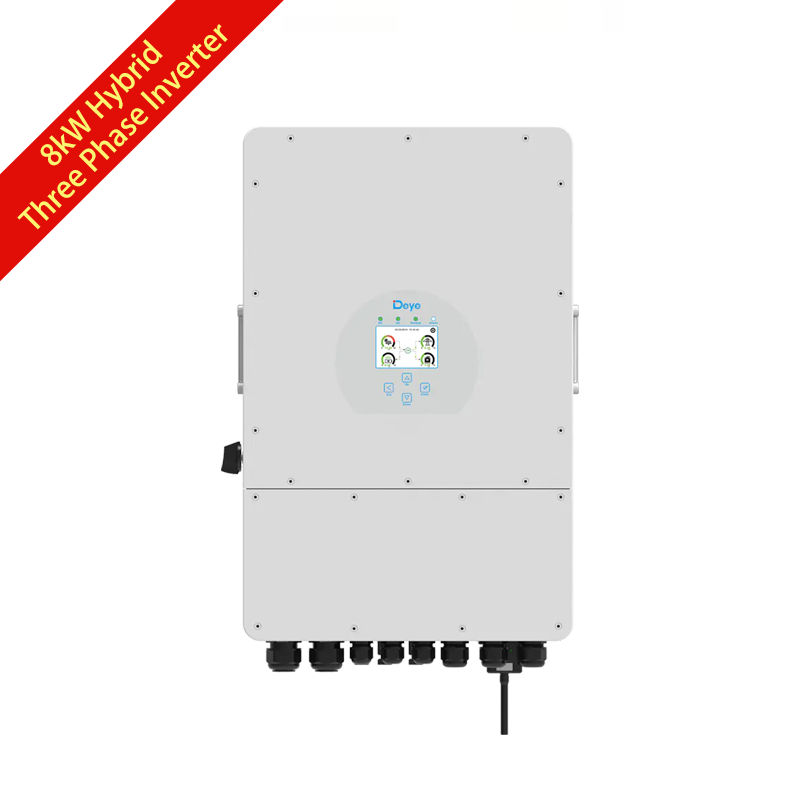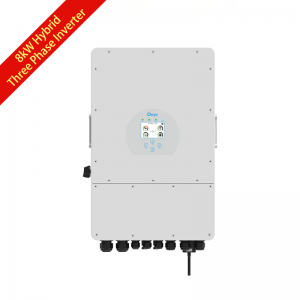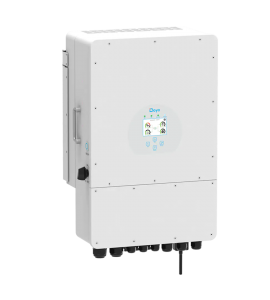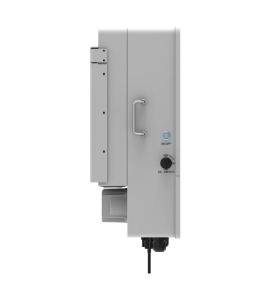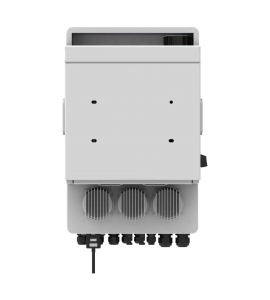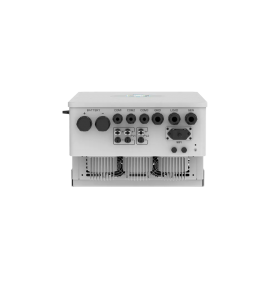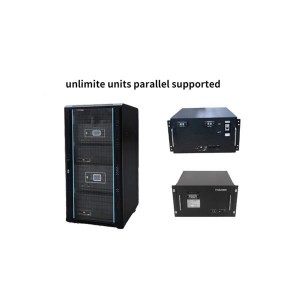

Deye 8kW Three Phase Hybrid Solar Inverter
ABOUT
Deye 8kW Three Phase Hybrid Solar Inverter
| Model | SUN-8K-SG04LP3-EU |
| Battery Input Data | |
| Battery Type | Lead-acid or Lithium-ion |
| Battery Voltage Range (V) | 40~60V |
| Max. Charging Current (A) | 190A |
| Max. Discharging Current (A) | 190A |
| Charging Curve | 3 Stages / Equalization |
| External Temperature Sensor | Yes |
| Charging Strategy for Li-Ion Battery | Self-adaption to BMS |
| PV String Input Data | |
| Max. DC Input Power (W) | 10400W |
| Rated PV Input Voltage (V) | 550V(160V~800V) |
| Start-up Voltage (V) | 160V |
| MPPT Range (V) | 200V-650V |
| Full Load DC Voltage Range (V) | 350V-650V |
| PV Input Current (A) | 13A+13A |
| Max. PV ISC (A) | 17A+17A |
| Number of MPPT / Strings per MPPT | 2/1 |
| AC Output Data | |
| Rated AC Output and UPS Power (W) | 8000W |
| Max. AC Output Power (W) | 8800W |
| Peak Power (off grid) | 2 times of rated power, 10 S |
| AC Output Rated Current (A) | 12.1/11.6 |
| Max. AC Current (A) | 18.2/17.4 |
| Max. Continuous AC Passthrough (A) | 45A |
| Output Frequency and Voltage | 50/60Hz;3L/N/PE 220/380Vac,230/400Vac |
| Grid Type | Three Phase |
| Current Harmonic Distortion | THD<3% (Linear load<1.5%) |
| Efficiency | |
| Max. Efficiency | 97.60% |
| Euro Efficiency | 97.00% |
| MPPT Efficiency | 99.90% |
| Protection | |
| PV Input Lightning Protection | Integrated |
| Anti-islanding Protection | Integrated |
| PV String Input Reverse Polarity Protection | Integrated |
| Insulation Resistor Detection | Integrated |
| Residual Current Monitoring Unit | Integrated |
| Output Over Current Protection | Integrated |
| Output Shorted Protection | Integrated |
| Output Over Voltage Protection | Integrated |
| Surge protection | DC Type II / AC Type Ⅲ |
| Certifications and Standards | |
| Grid Regulation | CEI 0-21, VDE-AR-N 4105, NRS 097, IEC 62116, IEC 61727, G99, G98, VDE 0126-1-1, RD 1699, C10-11 |
| Safety EMC / Standard | IEC/EN 61000-6-1/2/3/4, IEC/EN 62109-1, IEC/EN 62109-2 |
| General Data | |
| Operating Temperature Range (℃) | -45~60℃, >45℃ Derating |
| Cooling | Smart cooling |
| Noise (dB) | <45 dB |
| Communication with BMS | RS485; CAN |
| Weight (kg) | 33.6 |
| Size (mm) | 422W×699.3H×279D |
| Protection Degree | IP65 |
| Installation Style | Wall-mounted |
| Warranty | 5 years |
What is distributed PV distribution and storage?
PV power generation is the process of converting solar energy into electrical energy. Its output power depends on the weather and is easily affected by environmental factors such as solar radiation intensity and temperature. It has the characteristics of volatility, intermittent, and instability. With the continuous growth of grid-connected photovoltaic installed capacity, the demand for flexible and adjustable resources in the grid is becoming more and more urgent. For example, during the peak period of electricity consumption, the power grid is often overloaded; or when the power grid is outage in a large area, users are in the dilemma of "no electricity available". Hence the need for energy storage. The energy storage system is similar to a super-large "power bank". It can store electrical energy and release it when users need it, ensuring the stability of household electricity consumption, and at the same time shaving peaks and filling valleys to ease the pressure on power grids.
How does an energy storage system work?
Previously, we mentioned the working principle of the hybrid solar inverter - converting the direct current generated by the photovoltaic array into alternating current. Just as the soalr inverter is the heart of photovoltaics, the energy storage inverter is also the core component of the energy storage system. According to system differences, energy storage solar inverters are divided into hybrid solar inverters, AC-coupled energy storage inverters, off-grid energy storage inverters, etc. Among them, with the advantages of high integration and powerful functions, the inverter has become the sweet pastry in the hearts of users.
When short-term power outages are caused by thunderstorms and other conditions, the system cannot generate electricity, and the stored electric energy at this time can be used when the grid fails.
At night or on rainy days, the electricity stored in the battery can be converted into alternating current for home use; during peak power consumption, the grid and the battery provide power for the home; during off-peak hours in the morning, the grid can charge the battery.
In the case of long-term power outages caused by severe weather such as snow, when the solar system, grid and energy storage batteries are unable to supply power, the diesel generator can work, and the solar-storage hybrid solar inverter and generator complement each other to avoid long-term power outages.
